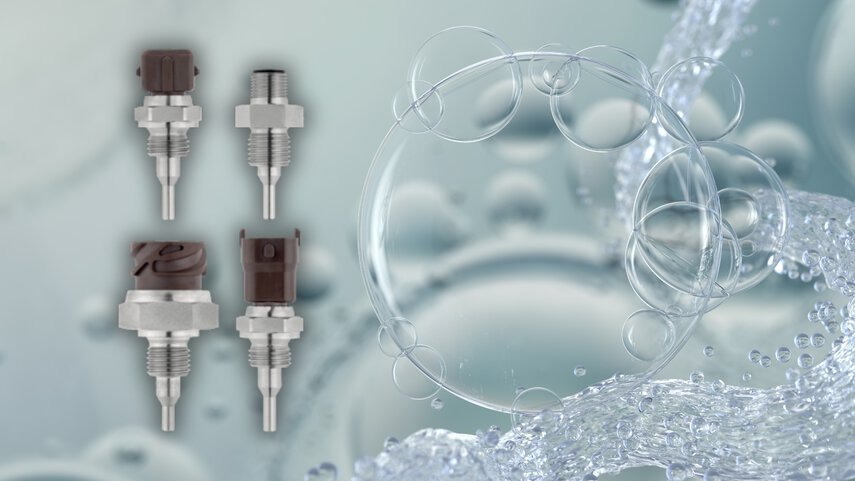

How to monitor fuel cell temperature?
Imagine a world where energy is generated without emissions, noise, or damage to the environment. Sound unrealistic? Think again. Reducing CO2 is a challenge that all industries will have to face sooner or later. The solution for a sustainable future is hydrogen, which powers emission-free technologies and is revolutionizing the energy sector. In fuel cells, it is not only a source of clean energy, but also a real tool in the fight against CO2 emissions.
One of the pioneers in the field of fuel cells is Proton Motor Fuel Cell GmbH, a German company that has been developing innovative hydrogen-based energy systems for over two decades. Thanks to its experience and advanced technology, it provides emission-free solutions for the automotive, marine, and rail sectors. To further increase the efficiency and safety of its systems, the company has decided to partner with JUMO, a provider of comprehensive solutions for the precise monitoring of key fuel cell operating parameters.
What challenges do fuel cell manufacturers face and how can modern measurement solutions help them overcome these challenges? Find out more in the rest of the article!
How do fuel cells work? The advantages of hydrogen for climate neutrality
The energy transition requires a shift to technologies that not only provide stable energy sources but also eliminate harmful emissions. Fuel cells play a key role here, as they enable energy to be generated in a clean, quiet, and efficient way, without exhaust emissions or other harmful by-products.
How do fuel cells work?
The operation of fuel cells can be most simply compared to a battery, in which a chemical reaction between hydrogen and oxygen produces electricity and heat. In PEM (polymer electrolyte membrane) technology, the fuel is hydrogen (H₂), which reacts with oxygen (O₂) taken from the air. The result of this reaction is pure water as the only waste product and electrical energy that can be used to power vehicles, buildings, or industrial systems.
Safety and stability of the technology
Unlike combustion engines or coal- and nuclear-powered power plants, fuel cells do not generate toxic substances, greenhouse gases or radioactive waste. Their quiet operation, high efficiency and ability to generate energy over long periods of time make them one of the most promising technologies of the future.
Why is hydrogen the fuel of the future?
- No CO₂ emissions – the only by-product is clean water.
- Possibility of using renewable energy sources – hydrogen can be produced using energy from the sun, wind or hydroelectric power plants.
- High efficiency – the energy generated in fuel cells is almost entirely utilized, with minimal losses.
- Versatile application – from vehicles and industry to emergency power and heating systems.

Hydrogen molecules
How to ensure safety and precision when monitoring fuel cells? Customer's problem
Proton Motor Fuel Cell GmbH specializes in the production of fuel cells for use in the transport, industrial, and energy sectors. To ensure their reliability, it is essential to precisely monitor their operating temperature. Fuel cells generate heat as a result of chemical reactions, and excess heat can lead to overheating and component degradation, while too low a temperature reduces process efficiency.
Failure to effectively monitor these parameters increases the risk of failure, which can have serious consequences, ranging from transport downtime to loss of stability in emergency power systems. Therefore, the company was looking for a solution that would enable continuous temperature control, rapid detection of irregularities, and optimization of cell operation while minimizing operating costs.
How does precise temperature monitoring affect the performance and safety of hydrogen systems? Our solution
To ensure optimum performance and safety of fuel cells, Proton Motor Fuel Cell GmbH has implemented a vibration-resistant resistive temperature sensor with a JUMO VIBROtemp plug. These measuring sensors have been designed for the demanding operating conditions found in fuel cell systems.
How does our solution work?
- Temperature monitoring at key points in the system
- Resistive temperature sensors are located in media adapter plates that distribute and monitor the coolant flow.
- Two probes control the temperature in the coolant circuit (forward and reverse flow), ensuring stable operating conditions for the cell.
- A third probe is located in the outlet stream of the chimney module's air path and monitors the temperature of the reaction air, preventing overheating.
JUMO VIBROtemp features a modular design that can be adapted to various applications thanks to a wide range of available plug-in connectors and protective materials. The special geometry of the protective connector additionally ensures extremely fast response times to temperature changes. A Pt100 temperature sensor compliant with DIN EN 60751, class B, in a two-wire circuit is used as standard, but variants with Pt500, Pt1000, PTC, and NTC sensors are also available, allowing flexible adaptation to specific system requirements. With a wide operating temperature range from -50 to +270°C (temporarily up to 300°C), the sensors are suitable for the most demanding applications, ensuring stability and long-term reliability of hydrogen technology.
How did resistive temperature sensors ensure reliable operation for a hydrogen fuel cell manufacturer? Customer benefits
The use of JUMO VIBROtemp temperature sensors in fuel cells at Proton Motor Fuel Cell GmbH has brought measurable benefits in terms of efficiency, safety, and system durability. Precise real-time temperature monitoring allows optimal operating conditions to be maintained, which translates into higher cell efficiency and longer component life. Thanks to their high resistance to vibration, changing atmospheric conditions, and pressure, the sensors are suitable for demanding industrial and mobile applications such as rail transport and automotive. Fast response to temperature changes minimizes the risk of system overheating, which in turn increases cell reliability and reduces the risk of failure. In addition, a wide operating temperature range (from -50 to +270°C) and the ability to customize device parameters for specific applications make JUMO VIBROtemp a reliable support for modern, environmentally friendly energy technologies.
Hydrogen technology is the future of sustainable energy, and precise temperature monitoring is crucial for its reliability and efficiency. With modern measurement solutions such as JUMO VIBROtemp, fuel cells can operate safely, efficiently, and longer.
If you would like to learn more about how our solutions support the development of modern technologies, contact us today! Discover the possibilities offered by measurement precision and join the innovative future of energy!
About the author
My name is Natalia and I specialize in content creation. For three years, I have been professionally sculpting words as an editor and copywriter. My mission is to break down even the most complex issues into their basic components. I focus on building relationships with readers and creating experiences. Privately, I am a lover of travel, literature, and fashion.
Your contact person

Sales Engineer
Jakub Dąbrowski +48882351471 jakub.dabrowski@jumo.net +48882351471Comments
We encourage you to leave your comments via the form below. They will be posted online once they have been approved through our review process.


